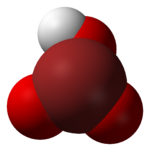
Back حمض البروميك Arabic اسید برومیک AZB Àcid bròmic Catalan Kyselina bromičná Czech Bromsäure German Bromata acido Esperanto Ácido brómico Spanish برومیک اسید Persian Bromihappo Finnish Brómsav Hungarian

| |

| |
| Names | |
|---|---|
| IUPAC name
Bromic acid
| |
| Other names
Bromic(V) acid
Hydrogen bromate | |
| Identifiers | |
3D model (JSmol)
|
|
| ChEBI | |
| ChEMBL | |
| ChemSpider | |
| ECHA InfoCard | 100.029.235 |
| EC Number |
|
| 25861 | |
| MeSH | Bromic+acid |
PubChem CID
|
|
| UNII | |
CompTox Dashboard (EPA)
|
|
| |
| |
| Properties | |
| BrHO3 | |
| Molar mass | 128.909 g·mol−1 |
| Acidity (pKa) | −2 |
| Conjugate base | Bromate |
Except where otherwise noted, data are given for materials in their standard state (at 25 °C [77 °F], 100 kPa).
| |
Bromic acid, also known as hydrogen bromate, is an oxoacid with the molecular formula HBrO3. It only exists in aqueous solution.[1][2] It is a colorless solution that turns yellow at room temperature as it decomposes to bromine.[1][3] Bromic acid and bromates are powerful oxidizing agents and are common ingredients in Belousov–Zhabotinsky reactions.[3][4] Belousov-Zhabotinsky reactions are a classic example of non-equilibrium thermodynamics.
- ^ a b The Merck Index: An Encyclopedia of Chemicals, Drugs, and Biologicals. 14th Edition. 2006.
- ^ Van Nostrand's Scientific Encyclopedia. Glenn D. Considine. Ninth Edition. Volume 1. p 554
- ^ a b Recipes for Belousov–Zhabotinsky reagents. J. Chem. Educ., 1991, 68 (4), 320. doi:10.1021/ed068p320
- ^ The Source of the Carbon Monoxide in the Classical Belousov–Zhabotinsky Reaction. J. Phys. Chem. A., 2007, 111 (32), 7805–12 doi:10.1021/jp073512+